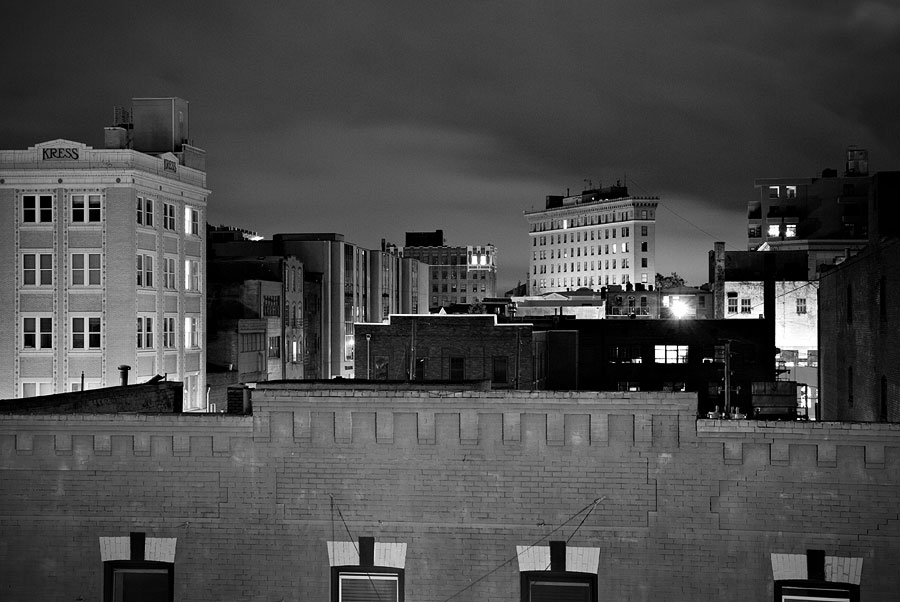


Skyline of downtown Asheville, looking toward the Flat Iron building. Photo by Max Cooper.
By David Forbes
The doldrums are over. “Real estate rebound in Asheville, N.C.” blared a recent headline from the Wall Street Journal.
It’s the latest in a long, long line of major media outlets to refresh themselves on the continued fact of our fair city’s existence; or “hip Asheville’s strengthening destination market” in their words. This particular piece pivoted on the McNabb couple (Darlene and John) one of those fortunate wealthy families who have hit that magic point where life becomes a calculus instead of a fight.
Apparently, while enjoying their $2.8 million Biltmore Forest home for a few months a year, they’re just one example of the well-heeled flocking to Asheville (or nearby, at least) now that the woes of the economy are shaking themselves off (and for many of their ilk, never hit at all). They’re paying in cash for homes to use a few months a year, or to sit vacant until they can sell them at a higher price later. Homes over $500,000 — still a huge price even in our inflated market — are going like hotcakes.. It’s driving up housing costs in many parts of the country, especially “destination” spots like our city, and leaving first-time home-buyers in a much tougher spot.
Around the same time as WSJ recounted the McNabbs’ odyssey, new population figures came out, showing that the Asheville area had steady, moderate growth since the 2010 census. Combined with the news that building permit numbers are at their highest level since 2008, it seems like the good times come again.
Not so fast. Keeping in mind the limits of one’s personal experience, there’s another story I’d like to add, more important than the McNabbs finding their palace. I’ve lived here for almost a decade, moving to Asheville just in time to remember the last era where affordable housing was doable, if tricky. In that time, I’ve known plenty of people that have moved in and out, usually here and there. Sometimes, this is part of the natural ebb and flow of any city.
Yet in the last month alone, I’ve known about ten talented people — from drastically different backgrounds, some natives, some with deep roots in the area — who are packing up and heading elsewhere. They’re searching for a place with better jobs, higher pay, more opportunity and less segregation.
The numbers on this won’t show up for awhile; this is happening just at that point where experience lingers ahead of statistics.
Forget the McNabbs. The rich are a dime a dozen, and fickle besides. That level of resources at one’s disposal generally encourages capriciouness. They’ll shift to another place, another home at the first scent of a hard wind or a different whim, because they can. This is, in the end, just another resort to them.
We can spare the occasional summer millionaire far more than we can spare a talented artist, a future reformer, a determined activist, a skilled maker, a potential founder. That’s Asheville’s hope, the people who believe in the city’s potential to be something better, who would make a home here if they could afford a decent place, food, savings and some say in the city’s future. They’ll fight. The McNabbs won’t.
But instead of a shot, even if a hard one, the future of Asheville comes home in the wee hours of the morning from a third job with nothing but a pittance in pay and an aching back. One day, it gets a bit much. Maybe they’ll glance at their sleeping kid. Maybe they’ll just collapse into the kitchen chair, voicing four words I’ve heard with increasing frequency in recent years.
“Fuck it, I’m moving.”
So they’ll leave. It won’t make headlines. Their departure won’t show up in the annual reports, because there’s no easy metric for lost opportunity.
The tragedy will lie in what isn’t done, isn’t made, isn’t built, in problems unfought and unsolved until too late.
For what it’s worth I personally know numerous people the above has happened to. The vast majority are cases of frustration — not planned life changes or lucky opportunities.
But in case you want something more measurable, here’s what we do have numbers for: the wages in Asheville and its surroundings are about $400 a month below the state average. That means that the average worker in North Carolina has $400 more to tackle their bills than the workers here. Despite an unusually high level of education, a third of Buncombe’s residents are low-income. Last year, Asheville saw a sharp rise in the numbers of young homeless.
Somehow, even other cities in our state have managed the trick of paying their workforce something above medieval levels. Somehow, they’ve also done so without making lists as one of the most unaffordable areas in the country.
Too often the seriousness of these issues isn’t appreciated, even locally, batted away with warnings to “focus on the positive” or dismissals of “that’s just how it goes here.”
But accomplishments, even real ones, don’t make problems go away; a house won’t stop burning because the porch is beautiful.
And the time comes when “that’s the way it is” is a route to disaster, when survival requires change that’s not universally comfortable or flattering. The worst issues Asheville’s people face aren’t yielding, and they threaten to undermine the future of the whole area. Cities that don’t tackle those end up footnotes or cautionary tales.
The migrating wealthy can find another palace if they wish; and the second the wind changes, they probably will. But this is not their home. It’s far past time to ask what a functioning city for the rest of us actually looks like.
Email questions or comments to ashevilleblade at gmail. If you like our work, support the Asheville Blade directly on Patreon.